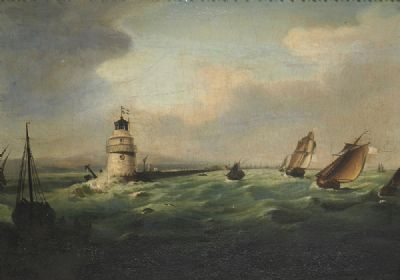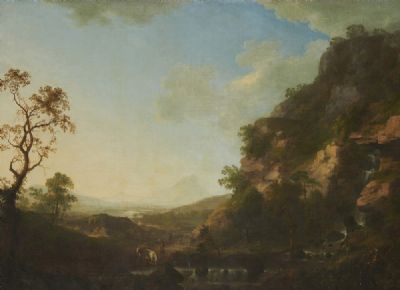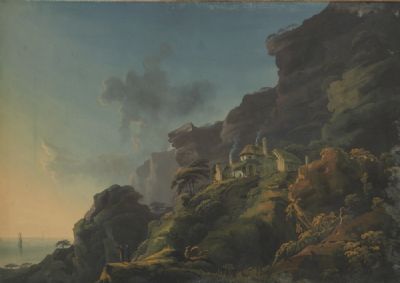Bidding on this item has ended.
William Ashford
ROCKY RIVER LANDSCAPE WITH TRAVELLERS AND A RUINED ABBEY
Lot 56
Price Realised:
€55,000
Estimate:
€30,000 - €50,000
William Ashford PPRHA, 1746-1824
ROCKY RIVER LANDSCAPE WITH TRAVELLERS AND A RUINED ABBEY
Oil on canvas, 48" x 60" (122 x 153cm), signed and dated 1802
It is difficult to disagree with Walter Strickland's assessment that Ashford's 'pic...
Read more
 Lot 56
William Ashford
ROCKY RIVER LANDSCAPE WITH TRAVELLERS AND A RUINED ABBEY
Lot 56
William Ashford
ROCKY RIVER LANDSCAPE WITH TRAVELLERS AND A RUINED ABBEY
 Lot 56
William Ashford
ROCKY RIVER LANDSCAPE WITH TRAVELLERS AND A RUINED ABBEY
Lot 56
William Ashford
ROCKY RIVER LANDSCAPE WITH TRAVELLERS AND A RUINED ABBEY
Estimate:
€30,000 - €50,000
William Ashford PPRHA, 1746-1824
ROCKY RIVER LANDSCAPE WITH TRAVELLERS AND A RUINED ABBEY
Oil on canvas, 48" x 60" (122 x 153cm), signed and dated 1802
It is difficult to disagree with Walter Strickland's assessment that Ashford's 'pictures justify the reputation he enjoyed as the foremost landscape painter of his time in Ireland' and this is one of the largest and most ambitious paintings that he ever completed. An expansive landscape dominated by crags on one side invites being read from the left, on which side its foreground is plunged in deep shade. The viewer moves via the spotlighted white horse on a bridge to the group of travellers in the brightness of the right foreground where two heavily-laden donkeys accompanied by an alert dog and two, seemingly lost, sheep progress past a cascade feeding into the river. In the middle distance distinctly Irish ecclesiastical ruins sit in the valley reminding of past settlement quite different from the gentle pastoral life that is evoked here. Very much an imaginary ('ideal') landscape, it is comparatively rare in this respect in Ashford's art. More generally - unlike, say, George Barret - his works is topographically inspired.
The whole composition is bathed in soft, crepuscular light, with the recession far into the distance reminding of a 1788 review of Ashford's work: 'his colouring, grouping and perspective deserve high commendation'. The composition owes much to his memory of the art of Thomas Roberts who had died more than two decades earlier. The canvas size that the artist generally preferred for his larger landscapes measures 30 x 40 inches though sometimes he painted on a canvas 50 inches across (the standard height for a full length portrait) making this an unusually large image for Ashford. Only a handful of paintings, including the pairs of views of Dublin painted for Lord Camden (National Gallery of Ireland) and the monumental view of Belan, County Kildare (Ballyfin Demesne) are larger. However, the composition works admirably on this large scale with a pleasingly controlled palette and real sense of the sweeping curve of the landscape.
William Ashford was born in Birmingham and christened in St Martin's parish church on 20 May 1746, but at the age of about eighteen he moved to Ireland, taking the position of clerk in the laboratory section of the Ordnance Office in Dublin Castle. It was in Ireland that Ashford spent his lifetime and he became our most successful landscape painter of the late eighteenth and early nineteenth centuries, succeeding his rival, and presumed friend, Thomas Roberts who died prematurely in 1777.
In 1767, aged twenty-one, Ashford submitted his first works to the Society of Artists in Ireland, an organisation of painters and sculptors who had constructed an octagonal exhibition room for annual displays in William Street, a move which galvanised art production in Ireland. Perhaps surprisingly Ashford's early exhibits were not in the landscape genre for which he is almost exclusively known today. Instead he showed two still-lifes, both titled A Group of Flowers. It was only in 1772 that landscapes, both topographical and demesne, appeared in the exhibitions and, hereafter, Ashford spent his entire, long career painting the Irish landscape in all its manifestations.
Among his early masterpieces was a pair of views of Dublin Bay looking north and south which he painted for Lord Dartrey and which were subsequently sold at Christie's in London on 6 March 1776. Ashford contributed to Thomas Milton's engraved views of Irish seats including portrayals of Bessborough, County Kilkenny (1785) and Ballyfin, County Laois (1787). In the period after about 1780 Ashford's style broadened somewhat and when a group of his works was offered in 1794, his stylistic progression could be assumed as public knowledge with the advertisement referring to 'two landscapes in his first style'. Ashford forged a close relationship with Lord Dartrey, his client for the Dublin Bay views, and he clearly had a winning manner which charmed his often noble clients with several of whom he established close friendships, notably Lord Aldborough. As James Gandon's son noted 'he was much noticed by all the distinguished lovers and encouragers of the fine arts of the day'.
Ashford continued to produce exceptional work in the following decades, noticeably the Charleville Forest series of 1801, which display a clear understanding of Picturesque theory as it had been codified by William Gilpin (1724-1804) and others in the previous decades. In addition to demesne landscapes and Dublin views, Ashford painted a few landscapes with literary narratives such as Jacques Contemplating the Wounded Stag, a subject taken from Shakespeare's As You Like It (private collection). Ashford became one of the key cultural figures in Dublin in the early decades of the nineteenth, a position recognised when, in 1823, he became the inaugural President of the Royal Hibernian Academy. But already in 1801, close in time to the work catalogued here, the anonymous diarist who gave an account of an exhibition in the former Parliament House on College Green described him as 'decidedly the first landscape painter'.
William Laffan, 2022
ROCKY RIVER LANDSCAPE WITH TRAVELLERS AND A RUINED ABBEY
Oil on canvas, 48" x 60" (122 x 153cm), signed and dated 1802
It is difficult to disagree with Walter Strickland's assessment that Ashford's 'pictures justify the reputation he enjoyed as the foremost landscape painter of his time in Ireland' and this is one of the largest and most ambitious paintings that he ever completed. An expansive landscape dominated by crags on one side invites being read from the left, on which side its foreground is plunged in deep shade. The viewer moves via the spotlighted white horse on a bridge to the group of travellers in the brightness of the right foreground where two heavily-laden donkeys accompanied by an alert dog and two, seemingly lost, sheep progress past a cascade feeding into the river. In the middle distance distinctly Irish ecclesiastical ruins sit in the valley reminding of past settlement quite different from the gentle pastoral life that is evoked here. Very much an imaginary ('ideal') landscape, it is comparatively rare in this respect in Ashford's art. More generally - unlike, say, George Barret - his works is topographically inspired.
The whole composition is bathed in soft, crepuscular light, with the recession far into the distance reminding of a 1788 review of Ashford's work: 'his colouring, grouping and perspective deserve high commendation'. The composition owes much to his memory of the art of Thomas Roberts who had died more than two decades earlier. The canvas size that the artist generally preferred for his larger landscapes measures 30 x 40 inches though sometimes he painted on a canvas 50 inches across (the standard height for a full length portrait) making this an unusually large image for Ashford. Only a handful of paintings, including the pairs of views of Dublin painted for Lord Camden (National Gallery of Ireland) and the monumental view of Belan, County Kildare (Ballyfin Demesne) are larger. However, the composition works admirably on this large scale with a pleasingly controlled palette and real sense of the sweeping curve of the landscape.
William Ashford was born in Birmingham and christened in St Martin's parish church on 20 May 1746, but at the age of about eighteen he moved to Ireland, taking the position of clerk in the laboratory section of the Ordnance Office in Dublin Castle. It was in Ireland that Ashford spent his lifetime and he became our most successful landscape painter of the late eighteenth and early nineteenth centuries, succeeding his rival, and presumed friend, Thomas Roberts who died prematurely in 1777.
In 1767, aged twenty-one, Ashford submitted his first works to the Society of Artists in Ireland, an organisation of painters and sculptors who had constructed an octagonal exhibition room for annual displays in William Street, a move which galvanised art production in Ireland. Perhaps surprisingly Ashford's early exhibits were not in the landscape genre for which he is almost exclusively known today. Instead he showed two still-lifes, both titled A Group of Flowers. It was only in 1772 that landscapes, both topographical and demesne, appeared in the exhibitions and, hereafter, Ashford spent his entire, long career painting the Irish landscape in all its manifestations.
Among his early masterpieces was a pair of views of Dublin Bay looking north and south which he painted for Lord Dartrey and which were subsequently sold at Christie's in London on 6 March 1776. Ashford contributed to Thomas Milton's engraved views of Irish seats including portrayals of Bessborough, County Kilkenny (1785) and Ballyfin, County Laois (1787). In the period after about 1780 Ashford's style broadened somewhat and when a group of his works was offered in 1794, his stylistic progression could be assumed as public knowledge with the advertisement referring to 'two landscapes in his first style'. Ashford forged a close relationship with Lord Dartrey, his client for the Dublin Bay views, and he clearly had a winning manner which charmed his often noble clients with several of whom he established close friendships, notably Lord Aldborough. As James Gandon's son noted 'he was much noticed by all the distinguished lovers and encouragers of the fine arts of the day'.
Ashford continued to produce exceptional work in the following decades, noticeably the Charleville Forest series of 1801, which display a clear understanding of Picturesque theory as it had been codified by William Gilpin (1724-1804) and others in the previous decades. In addition to demesne landscapes and Dublin views, Ashford painted a few landscapes with literary narratives such as Jacques Contemplating the Wounded Stag, a subject taken from Shakespeare's As You Like It (private collection). Ashford became one of the key cultural figures in Dublin in the early decades of the nineteenth, a position recognised when, in 1823, he became the inaugural President of the Royal Hibernian Academy. But already in 1801, close in time to the work catalogued here, the anonymous diarist who gave an account of an exhibition in the former Parliament House on College Green described him as 'decidedly the first landscape painter'.
William Laffan, 2022
- Enquire
- View all lots by this artist
- How bidding works
Please note: You will require a deVeres account in order to bid. Please register via the website. Each lot will close numerically. If there is late bidding the time may be extended which could delay subsequent lots. The lots will start to close from 2.00pm on auction day, closing at 45 second intervals.
PLEASE BID EARLY TO AVOID DISAPPOINTMENT.
In order to allow rival bidders the opportunity to respond to a late bid the following extensions will apply:
IF A BID IS RECEIVED WITHIN THE FINAL 45 SECONDS OF THE COUNTDOWN THE CLOCK WILL RESET TO 60 SECONDS.
At any point you can leave a maximum bid, representing the highest price you are prepared to pay for a particular lot. Bidding only advances when there is competition from a rival bidder. In that case the system bids on your behalf, only up to the maximum if required. All bids are relayed to you be email, along with notification if you have been outbid.
All maximum bids are confidential and not disclosed. The system will endeavor to purchase the lot for you for the least price. Bids are subject to buyer’s premium of 25% (incl vat), with no additional charges.
In the event of a tied bid, the preference will be given to the bid submitted first. The second bidder will receive immediate notification of being outbid.
PLEASE BID EARLY TO AVOID DISAPPOINTMENT.
In order to allow rival bidders the opportunity to respond to a late bid the following extensions will apply:
IF A BID IS RECEIVED WITHIN THE FINAL 45 SECONDS OF THE COUNTDOWN THE CLOCK WILL RESET TO 60 SECONDS.
At any point you can leave a maximum bid, representing the highest price you are prepared to pay for a particular lot. Bidding only advances when there is competition from a rival bidder. In that case the system bids on your behalf, only up to the maximum if required. All bids are relayed to you be email, along with notification if you have been outbid.
All maximum bids are confidential and not disclosed. The system will endeavor to purchase the lot for you for the least price. Bids are subject to buyer’s premium of 25% (incl vat), with no additional charges.
In the event of a tied bid, the preference will be given to the bid submitted first. The second bidder will receive immediate notification of being outbid.
Sign-up to our auction alert
Signup for personalised Irish art recommendations, invitations to viewings and auctions, articles and more.



 View More Videos
View More Videos DVTV Click Here To View Video
DVTV Click Here To View Video


